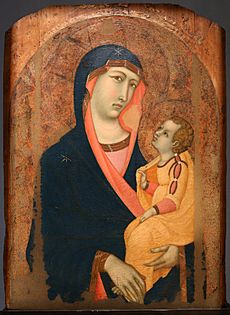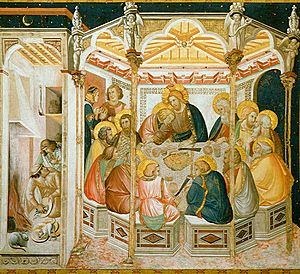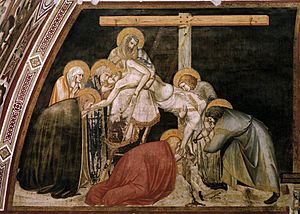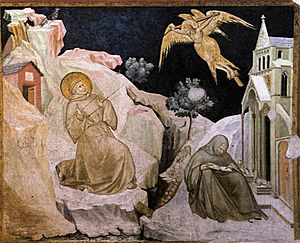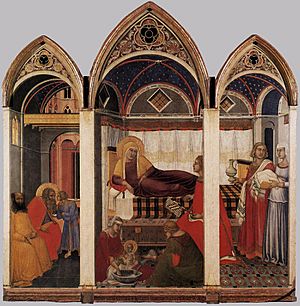Pietro Lorenzetti facts for kids

Pietro Lorenzetti (born around 1280 – died 1348) was an Italian painter. He was active between about 1306 and 1345. With his younger brother Ambrogio, he brought a more realistic style, called naturalism, to Sienese art. Their art and experiments with making things look three-dimensional helped prepare the way for the Renaissance art period.
Contents
Who Was Pietro Lorenzetti?
We don't know much about Pietro Lorenzetti's life. He was likely born in Siena, Italy, in the late 1200s. He probably died there in 1348 from the Black Death, a terrible disease that spread across Europe. His younger brother, Ambrogio, was also a famous artist. For a long time, people didn't know they were brothers because of a mistake in reading Pietro's name.
Pietro worked in several Italian cities like Assisi, Florence, and Siena. We don't know the exact order of his work. His paintings show influences from other great artists like Duccio, Giotto, and Giovanni Pisano.
One of his first big breaks was painting frescoes (wall paintings) on the outside of Siena's Ospedale della Scala. These paintings, now believed to be by both Lorenzetti brothers, were later destroyed.
Many of Pietro's religious artworks can still be seen today. You can find them in churches and museums in towns like Arezzo, Assisi, and Siena. His last known work, the Nativity of the Virgin (painted around 1335–1342), is in the Museo dell'Opera del Duomo in Siena.
Famous Paintings by Pietro Lorenzetti
The Castiglione d'Orcia Madonna
The Madonna of Castiglione d'Orcia was painted before 1300. It is one of Lorenzetti's earliest surviving works. In this painting, the figures look calm and thoughtful. The Child's clothes are fancy and modern for the time. The Virgin Mary wears a dark blue cloak with a gold border.
Some parts of the painting are traditional, like how the Virgin's head is tilted. This is similar to earlier paintings by Duccio. However, Lorenzetti's Madonna also shows something new: a sense of realism. The Virgin's body seems to realistically hold the weight of the Child. This kind of natural holding was new in paintings, though it could be seen in sculptures from that time.
Frescoes in the Basilica of Saint Francis of Assisi
Pietro Lorenzetti's most important work might be the Passion fresco cycle in the Lower Church of San Francesco in Assisi. These seventeen well-preserved wall paintings are a highlight of his early career. They show influences from Giotto's grand style and Duccio's teachings. Painting in the lower church was hard because there was very little natural light.
Scholars believe Lorenzetti finished this series of frescoes in one go, between 1316 or 1317 and 1319. One of his earliest works here (started around 1310) is the Madonna and Child with Saints Francis and John the Baptist.
Lorenzetti's fresco cycle starts with scenes like the Entry into Jerusalem, the Last Supper, and the Crucifixion.
The artists painted these scenes from the top of the vaulted roof downwards. This stopped paint from dripping onto finished parts below.
In the Last Supper, Jesus and his disciples sit around a table. In a small kitchen next to them, a man washes dishes. A dog licks a plate, and a cat sleeps. Lorenzetti added a surprising detail here: the pets and plates cast clear shadows. These shadows are angled correctly, showing where the light source (a fire) would be.
The Crucifixion is the largest fresco and one of Lorenzetti's greatest paintings.
Two scenes on the end wall, the Deposition from the Cross and the Deposition in the Tomb, show people sadly taking Christ from the cross. They gently place his body in the tomb. These scenes show Lorenzetti's skill and how he used natural human emotions, similar to Giotto.
In front of the Crucifixion is the Stigmata of Saint Francis. This painting shows Saint Francis receiving the wounds of Christ. It suggests a link between the life of Christ and Saint Francis. Lorenzetti even placed Saint Francis next to the Capture of Christ scene.
The Madonna dei Tramonti (meaning 'Madonna of the Sunsets') is below the Crucifixion. It shows the Madonna and Child with Saint John the Evangelist and Saint Francis. Mary makes a special gesture, pointing her thumb back to Saint Francis.
The last image in Lorenzetti's Assisi frescoes shows portraits of Saints Rufino, Catherine of Alexandria, Clare, and Margaret. They appear above a bench with a clever artistic trick. The bench looks three-dimensional, and its shadow seems to come from a single light source, just like in real life.
The Monticchiello Altarpiece
The Monticchiello Altarpiece was likely painted around 1315 for a church in Monticchiello, Tuscany. It probably included the Monticchiello Madonna and paintings of several saints.
The Arezzo Polyptych
The Arezzo Polyptych is a large altarpiece with three levels. It was ordered in 1320 by Bishop Guido Tarlati for a church in Arezzo. In the middle is the Madonna (Mary) and Child, wearing a beautiful robe. On the sides are saints like John the Evangelist and Donatus, the patron saint of Arezzo. The painting uses rich colors and graceful lines. It has a lively feel that was rare in art from Siena at that time.
This polyptych (a painting with many panels) is Lorenzetti's first work with a known date (around 1320–1324). It helps experts understand his painting style during that period.
The Carmelite Altarpiece
The Carmelite Altarpiece was a polyptych ordered in 1329 for the Carmelite Order of friars. The main part showed the Madonna and Child with Saint Nicholas and Elijah. Side panels featured other saints. Below these, a section called the predella had five smaller paintings. These paintings told stories from the history of the Carmelite Order, not from the Bible.
A cool thing about this altarpiece is its wide central predella panel. This allowed the painter to show the Carmelite rule being given in great detail. Elijah was important to the Carmelites because they believed he founded their order. This altarpiece also showed a new step in Lorenzetti's style, making figures look more three-dimensional.
The Carmelite Altarpiece was sold in 1818 and then lost. It was later found hidden underneath another painting during a restoration. Clues like the figure of Elijah and the Carmelite colors in the costumes helped restorers identify it. The painting is signed and dated by Pietro Lorenzetti himself.
The Birth of the Virgin
Lorenzetti's last major work (1342) was a triptych altarpiece (a painting with three panels) called the Birth of the Virgin. It was made for Siena Cathedral. This painting celebrates the life of the Virgin Mary, who was the patron saint of Siena.
The Birth of the Virgin was the third painting in a series for Siena Cathedral. The series started with Duccio's Maestà and included Simone Martini's Annunciation. Duccio, Simone, and Pietro were all part of the Sienese School of painting.
Unlike Duccio's grand depiction of the Virgin or Simone's more supernatural scene, Pietro's Birth of the Virgin shows the Virgin in a very real, everyday setting. In this painting, someone is pouring a bath for the Virgin. Midwives are helping Saint Anne, who is resting on a bed covered with a plaid blanket. An excited father waits for news of the birth. The people look solid and real. If not for their halos (crowns of light) and Saint Anne's unusually large body, this painting could look like a scene from ordinary life.
One amazing thing about Birth of the Virgin is how Pietro used spatial illusion. He likely learned from his brother, Ambrogio. Pietro made the painting's frame and the painted architecture blend together. This creates a smooth, continuous world. The columns and bed frame in the painting help create a sense of depth. The vaulted ceilings also add dimension to the rooms. In the left panel, you can even see a nearby building outside, adding more depth. This painting is considered one of the most convincing interior spaces painted in the 1300s.
Pietro's new way of using space in Birth of the Virgin makes him one of the great masters of 14th-century Sienese art.
See also
 In Spanish: Pietro Lorenzetti para niños
In Spanish: Pietro Lorenzetti para niños


